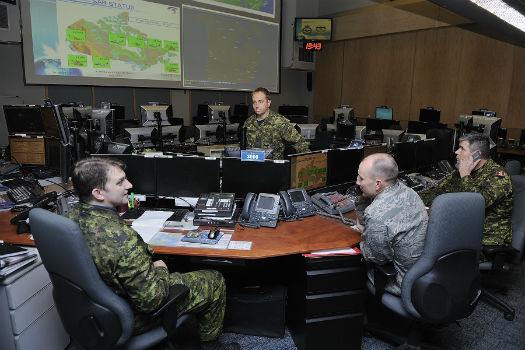RCAF Press Release | December 18, 2014
Estimated reading time 3 minutes, 42 seconds.
Canadian and American personnel work side-by-side in the Canadian Air Operations Centre (CAOC), located at 1 Canadian Air Division Headquarters/Canadian NORAD Region in Winnipeg, Man., to safeguard North America. Corporal Beverley Dunbar Photo
It has been said that flexibility is the key to air power, but at the same time, it is critical to maintain command and control of one’s forces.
To achieve both, the Royal Canadian Air Force (RCAF) employs a system of centralized command with de-centralized execution. This allows the chain of command to retain control of forces and what they are doing – while providing units at the tactical level with the flexibility to accomplish their missions.
It is a well-thought out – but delicate – balance, but maintaining command and control is not easy. This is particularly true for air forces, which may have different aircraft conducting different missions in different parts of the world, but all at the same time.
This balance is maintained at 1 Canadian Air Division/Canadian NORAD Region (1 CAD/CANR) Headquarters in Winnipeg, Man. Major-General David Wheeler, the commander of 1 CAD/CANR, is responsible for all RCAF operations.
These operations generally fall under two categories.
The first is NORAD operations, which are focused on the aerospace defence of North America.
The second is in the commander’s role as the Joint Forces Air Component Commander (JFACC) for the Canadian Joint Operations Command, which runs all operations for the Canadian Armed Forces.
In order to manage this complicated responsibility, Major-General Wheeler relies on the 1 CAD/CANR Combined Aerospace Operations Centre (CAOC).
“The CAOC is a weapon system,” says Brigadier-General Charles Hyde of the United States Air Force, who is the deputy commander of CANR and the deputy JFACC.
“The ability to develop an air strategy, to design an air campaign, the ability to plan and execute air operations, and the ability to sustain operations to achieve a desired end-state using the means of air power – that is what this CAOC does.”
In effect, the CAOC is a group of sections that encompass all the elements necessary for operations: strategy, planning, current operations, intelligence, air mobility, mission support, training and standards. The sections work together as one cohesive system to command and control air power. It includes the Air Operations Centre, a control room of sorts that is epicentre of operational command and control, and the various divisions that support operations.
As Brigadier-General Hyde points out, it is this construct that allows for the RCAF to project power and punch above its weight.
“There’s a difference between air power and just having aircraft.
“What makes the transition from having aircraft to air power is the ability to command and control it through [the] weapon system that is the CAOC,” he says.

